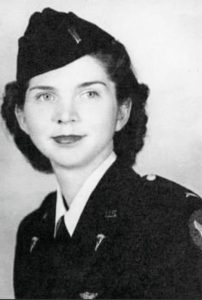Meet the former US Army flight nurses whom I interviewed for
Beyond the Call of Duty: Army Flight Nursing in World War II.
In 1986 as part of my research about flight nurse history and coping with war, I was privileged to interview 25 former US Army nurses about events of their flight nurse duty in World War II. Most of them are now deceased, but their stories live on in Beyond the Call of Duty: Army Flight Nursing in World War II.
The journal I kept of my time with each of them in 1986 when writing my dissertation offers a brief personal glimpse of these remarkable women. I am sharing edited versions of these journals, in the order in which the interviews took place. The actual interviews are in separate documents.
8th Interview
Anonymous Interviewee “Anon”
812 MAES Pacific
30 April 1986
My visit with this flight nurse who wished to remain anonymous and whom I’ll call Anon was all that I had hoped it would be. While she was not as talkative as other women have been, she was articulate and provided much valuable information. I must admit that my expectations were high: Anon was my initial contact, and it was through her that I was able to contact many other potential informants.
Getting to the state in which Anon lives was not without its problems. I couldn’t decide what to wear and how cold it might be. (I wonder at times whether the women I interview might actually enjoy seeing me in my uniform; Anon, for example, asked if my flight nurse wings were still silver with an “N”.)
“The best laid plans” went astray, as the saying goes, especially when it comes to regional airlines. After a change of planes, I was to arrive at my destination mid afternoon. Warning lights on the plane prior to takeoff from an en route stop, however, necessitated a change in travel plans. The airline put all the passengers on a bus and drove us to the airport. It gave me a chance to see more of the state than I would have seen from the air, but since I arrived three hours later than expected, no one was there to meet me. Then I learned that the airline hadn’t passed on the estimated arrival time of the bus. Just as I found an employee to help me, Anon arrived at the counter.
Anon and her husband, whom I’ll call Al, were like family—so nice and not at all bothered by the delay. They’d returned home and called a toll-free number to learn my estimated time of arrival; then I got in a bit early. We drove to their lovely home in a quiet neighborhood of a rural town, chatting all the way. While Al was finishing up preparations for dinner, I interviewed Anon. We took a break to enjoy a wonderful home-cooked meal, and while Al cleaned up after dinner—Anon says he’s been doing all the cooking lately—Anon and I concluded the interview.
When asked how she felt about being a flight nurse, Anon answered with pride, “I thought we were doing something real good. And I was proud of what we were doing.” Her only regret was that she never quite conquered her fear of flying in turbulent weather. Her patients never saw Anon’s fear, for she hid it behind a calm composure. But concern for her patients’ safety, should she need to get them into rafts on over-water flights, was uppermost in her mind once the plane stated bouncing.
After visiting for a while, Anon and Al drove me to my motel near the airport. Anon says I could have stayed with them and had my own room and bath, but we agreed that the motel would be more convenient for the next morning’s travel.
One of Anon’s stories: It took three or four months before the flight nurses in Anon’s squadron began flying air evac missions in earnest, so they were “at loose ends quite a bit of the time.” The nurses had brought very little with them overseas, and blackout conditions were in effect, limiting some activities. Someone gave them a big dance party, and a lot of the flight nurses met boyfriends, which helped pass the time. ”Only we were so impatient to get going with our work,” Anon said.
Anon died in 2010.



